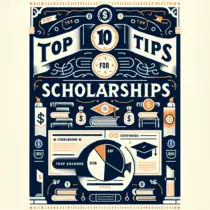Navigating the world of scholarships can feel overwhelming, especially given the sheer number and variety of opportunities available. This guide aims to provide a clear, step-by-step approach to help students find and apply for scholarships. From understanding the basics to crafting winning applications, this comprehensive guide leaves no stone unturned.
Understanding Scholarships
Scholarships are financial awards designed to help students pay for their education. Unlike loans, scholarships generally do not need to be repaid. They can come from various sources including universities, private organizations, non-profits, and government bodies. Scholarships can cover tuition fees, books, and sometimes even living expenses.
Types of Scholarships
Scholarships can be broadly categorized into several types:
- Merit-Based Scholarships: These are awarded based on academic, artistic, or athletic achievements.
- Need-Based Scholarships: These are given to students who demonstrate financial need.
- Minority Scholarships: These are aimed at supporting students from underrepresented groups.
- Field of Study Scholarships: Targeted at students pursuing specific fields, like engineering or medicine.
- Local Scholarships: Offered by local organizations or companies, typically for residents of a particular area.
Where to Find Scholarships
Finding scholarships requires research and dedication. Here are some effective ways to locate scholarship opportunities:
- School Counseling Offices: High school and college counseling offices often have a list of available scholarships.
- Online Scholarship Databases: Websites like Fastweb, Scholarships.com, and Chegg are robust tools for finding scholarships tailored to specific needs and qualifications.
- University Websites: Many universities list scholarships available to incoming and current students.
- Local Libraries: Libraries may have scholarship guides and databases.
- Professional Organizations: Many trade and professional groups offer scholarships to students pursuing careers in their fields.
How to Apply for Scholarships
Applying for scholarships involves several critical steps. Understanding and following these steps can greatly increase your chances of securing funding.
Step 1: Prepare a Scholarship Resume
A scholarship resume should highlight academic achievements, extracurricular activities, leadership roles, work experience, and volunteer work. It should be concise, typically no more than one page long.
Step 2: Gather Transcripts and Test Scores
Many scholarships require official transcripts and standardized test scores like the SAT or ACT. Request these documents from your school early, as processing times can vary.
Step 3: Obtain Letters of Recommendation
Letters of recommendation should come from individuals who can speak to your academic abilities, character, and potential. These might include teachers, coaches, or employers. Give your recommenders ample time to write and submit their letters.
Step 4: Write a Strong Personal Statement
A well-crafted personal statement can set you apart from other applicants. Start with an engaging introduction, clearly address the prompt, and highlight your achievements, goals, and why you deserve the scholarship. Proofread thoroughly to avoid any errors.
Step 5: Complete the Application Forms
Fill out all required fields accurately and honestly. Double-check your work to ensure everything is correct, and don’t leave any fields blank unless explicitly allowed.
Step 6: Submit Before Deadlines
Organization is key when applying for multiple scholarships. Keep track of all application deadlines and submit your materials well in advance.
Crafting a Winning Scholarship Essay
Most scholarships require an essay component. A compelling essay can make a tremendous difference in whether or not you receive the scholarship.
- Understand the Prompt: Ensure you fully understand the essay prompt and what the scholarship committee is looking for.
- Be Authentic: Write in a voice that is true to yourself. Authenticity resonates more than trying to fit a particular mold.
- Highlight Your Strengths: Clearly articulate your strengths, accomplishments, and how the scholarship will help you achieve your goals.
- Structure Effectively: Use a clear structure with an introduction, body, and conclusion. Each paragraph should flow logically into the next.
- Edit and Proofread: Spelling and grammar errors can detract from your message. Have someone else review your essay to catch mistakes you might have missed.
Financial Need Statements
Some scholarships require a financial need statement. This statement should detail your financial situation, explain any extenuating circumstances, and show how receiving the scholarship will alleviate financial burdens.
- Be Honest: Provide an accurate description of your financial situation without exaggerating.
- Use Specific Examples: Concrete examples make a compelling case for financial need.
- Show a Clear Connection: Explain how the scholarship will directly impact your ability to attend and succeed in school.
Interviews
Some scholarships involve an interview process. Preparing for these interviews is crucial.
- Research the Organization: Understand the mission and values of the organization offering the scholarship.
- Practice Common Questions: Practice answers to common interview questions, such as why you deserve the scholarship or how you plan to use the funds.
- Be Professional: Dress appropriately, be punctual, and show courteous behavior during the interview.
- Follow Up: A thank-you email after the interview can leave a positive impression.
Avoiding Scholarship Scams
Unfortunately, not all scholarship opportunities are legitimate. To avoid scams, be wary of any scholarship that:
- Requires an Application Fee: Legitimate scholarships do not require payment to apply.
- Guarantees You’ll Win: No legitimate scholarship can guarantee a win.
- Asks for Sensitive Information: Be cautious if asked for Social Security numbers or bank details.
- Sounds Too Good to Be True: If an offer promises an unusually large amount of money for little effort, it may be a scam.
Utilizing Scholarship Awards
Once you win a scholarship, it’s important to understand how to use the funds responsibly.
- Understand the Terms: Some scholarships come with specific terms and conditions regarding how the money can be used.
- Communicate with Your Financial Aid Office: Inform your school’s financial aid office about any scholarships you receive to ensure proper allocation.
- Save Documentation: Keep all award letters and documentation for your records.
Continuing to Search for Scholarships
Don’t stop searching for scholarships after your first round of applications. New opportunities arise all the time, and many scholarships are available for students already enrolled in college.
- Regularly Check Scholarship Databases: Continually search for new scholarships that align with your interests and qualifications.
- Apply for Smaller Awards: Don’t overlook smaller scholarships. While they may only cover books or supplies, they can add up and make a significant difference.
- Stay Active in Your Community: Volunteering and participating in extracurricular activities can open up additional scholarship opportunities.
Conclusion
Securing scholarships requires diligence, organization, and perseverance. By understanding the types of scholarships available, where to find them, and how to apply effectively, students can ease the financial burden of their education. Scholarships not only provide funding but also recognize and reward students for their achievements and potential. So, stay motivated, apply early, and keep your eyes on the prize. With the right approach, the seemingly daunting world of scholarships becomes a valuable path to academic and personal success.






